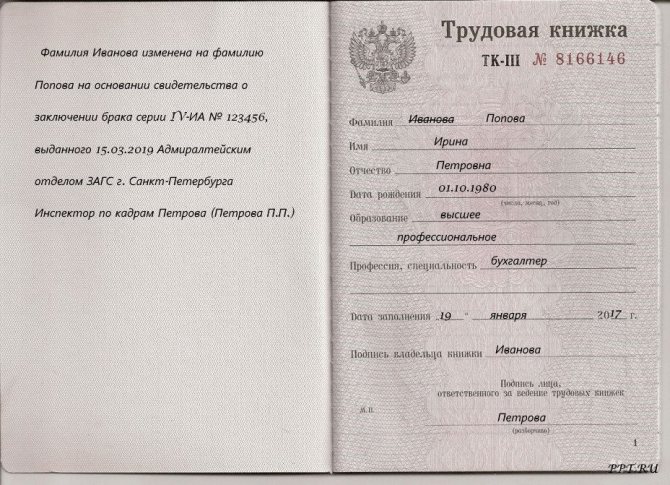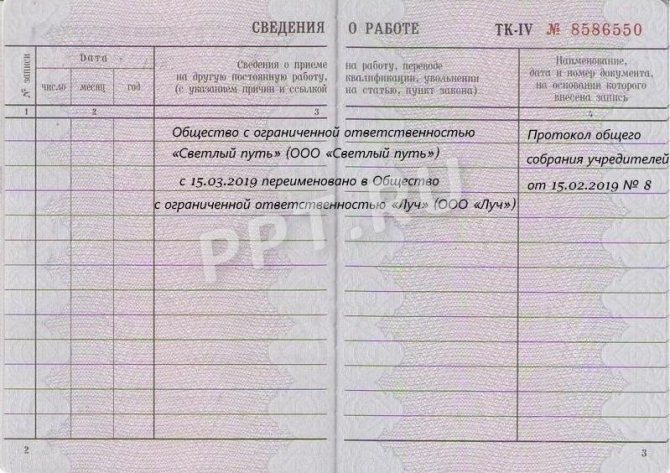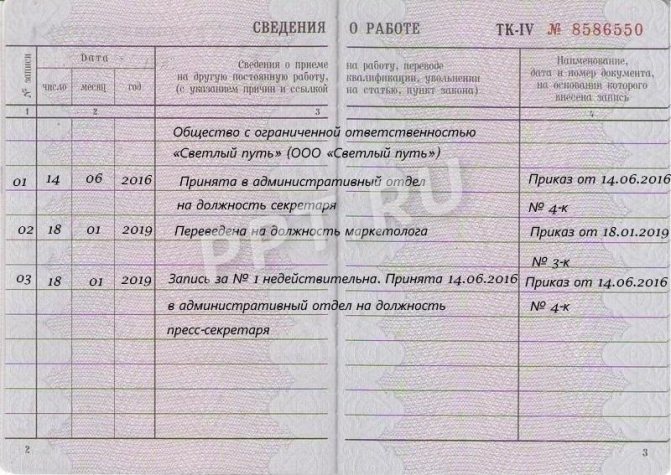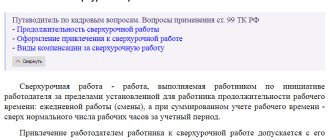Article 66 of the Labor Code is devoted to the description of such an important personnel tool as a work book.
It documents the rules for its maintenance and a list of information entered into it by the employer. Labor Code of the Russian Federation
dated December 30, 2001 N 197-FZ
Full text of the article, guides, additional information - in ConsultantPlus
What is a work book
In our state, any citizen who has reached the age of 14 can begin official work. And from that moment on, he has such an official personal document as a work book. It records the entire “work biography” of a person.
Many people underestimate the importance of this document, and yet it is as valuable as, for example, a passport, and without a work book it is sometimes simply impossible to get a good job.
The book itself is a brochure-form of a standard form and in order for the information contained in it to have legal force, it must be properly executed.
How work books are prepared and maintained
A work book can only be issued in an organization; individual entrepreneurs cannot make any entries about themselves in it, but they are allowed to enter data about a person working for them under an employment contract.
The work book form is freely available, but more often it is issued at the first place of work after drawing up an employment contract. The employer is required to issue this document within 5 days from the date the person begins working.
Each entry must be made only on the basis of the relevant order and no later than seven days from the date of its signing.
All entries are made by an authorized person, assigned by order, and after making the next note, the book must be familiarized with the employee - the owner of the work book.
According to the general rules, all entries are made in Russian, with a black, blue or purple pen. Abbreviations are not allowed. The rules for maintaining work records are set out in more detail in a special Instruction approved by Resolution of the Ministry of Labor of the Russian Federation dated October 10, 2003 No. 69.
Responsibility for compliance with the procedure for maintaining work books
The employer is responsible for the correct execution and safety of this important document. The manager usually does not personally conduct personnel records, but hires an employee according to the staffing table, or assigns responsibilities for personnel work to one of the organization’s employees. For improper performance of official duties, penalties provided for by the Labor Code may be imposed.
Failure to comply with the procedure for maintaining work records is an administrative offense, for which a fine may be imposed on officials of the organization, and in case of repeated violation of the same norms of the Administrative Code, a measure of liability in the form of disqualification for up to three years.
Work book structure
The work book has the following structure:
- cover with the inscription “Work book”.
- The title page, which reflects the personal information of the owner, as well as the individual series and number of the document.
- Two sections – “Information about the work” and “Information about the award”. The first section contains the following columns: serial number, date of entry, information about hiring, information about qualifications, information about dismissal with reasons. The documents on the basis of which the relevant entries are made are also indicated.
Article 66 of the Labor Code of the Russian Federation. Work book (current edition)
10. The employer is obliged, upon a written application from the employee, no later than three working days from the date of its submission, to give the employee a copy of the work record book or an extract from the work record book certified in the prescribed manner (clause 7 of the Rules for maintaining and storing work records).
11. The procedure for filling out work books, inserts in them, duplicates of work books is established by the Instructions for filling out work books, approved. Resolution of the Ministry of Labor of Russia dated October 10, 2003 N 69 in accordance with clause 13 of the Rules for maintaining and storing work books.
12. In accordance with clause 1.1 of the said Instructions, dates in all sections of work books are written in Arabic numerals (day and month - two digits; year - four digits). For example, if an employee was hired on September 5, 2009, an entry is made in the work book: “09/05/2009”. Entries are made carefully, using a fountain or gel pen, a rollerball pen (including a ballpoint pen), light-resistant ink (paste, gel) in black, blue or purple, and without any abbreviations. For example, it is not allowed to write “pr.” instead of “order”, “order” instead of “order”, “trans.” instead of “translated”, etc.
According to clause 1.2 in the sections “Information about work” and “Information about awards” of the work book, crossing out previously made inaccurate, incorrect or other invalid entries is not allowed.
If it is necessary to change a specific entry, for example about hiring, in the “Job Information” section, after the corresponding last entry in this section, indicate the subsequent serial number, the date the entry was made, in column 3 an entry is made: “The entry with the number such and such is invalid.” . After this, the correct entry is made: “Accepted in such and such a profession (position)” - and in column 4 the date and number of the order (instruction) or other decision of the employer, the entry from which was incorrectly entered into the work book, is repeated, or the date and number of the order are indicated (order) or other decision of the employer, on the basis of which the correct entry is made.
In the same manner, a record of dismissal or transfer to another permanent job is invalidated if the dismissal or transfer is recognized as illegal by the employer, the control and supervisory body, the labor dispute resolution body or the court and reinstatement to the previous job or the wording of the reason for dismissal is changed. For example: “The entry for number so-and-so is invalid, reinstated to previous job.” If the wording of the reason for dismissal is changed, an entry is made: “The entry for number so-and-so is invalid, dismissed (new wording is indicated).” Column 4 makes reference to the order (instruction) or other decision of the employer on reinstatement or changing the wording of the reason for dismissal.
If there is an entry in the work book about dismissal or transfer to another permanent job, which is subsequently declared invalid, upon the written application of the employee, a duplicate work book is issued without making an entry declared invalid. In this case, in the upper right corner of the first page of the duplicate work book the inscription is made: “Duplicate”. On the first page (title page) of the previous work book it is written “A duplicate was issued in exchange” - indicating its series and number.
13. According to clause 2.1 of the Instructions, information about the employee is filled out as follows:
- surname, name and patronymic are indicated in full, without abbreviation or replacement of the name and patronymic with initials; the date of birth is recorded in full (day, month, year) on the basis of a passport or other identification document (for example, a military ID, foreign passport, driver’s license);
- registration of education (basic general, secondary general, primary vocational, secondary vocational, higher vocational and postgraduate vocational) is carried out only on the basis of properly certified documents (certificate, certificate, diploma, etc.);
— a record of incomplete education at the appropriate level can be made on the basis of submitted duly certified documents (student card, grade book, certificate from an educational institution, etc.);
- profession and (or) specialty are indicated on the basis of documents on education, qualifications or the presence of special knowledge (when applying for a job that requires special knowledge or special training) or other properly executed documents.
14. After indicating the date of filling out the work book, the employee, with his signature on the first page (title page) of the work book, certifies the correctness of the information entered (clause 2.2 of the Instructions).
The first page (title page) of the work book is also signed by the person responsible for issuing work books, after which the seal of the organization (stamp of the personnel service) where the work book was first filled out is affixed.
15. Changes to entries in work books are made in the following order:
- about last name, first name, patronymic and date of birth - on the basis of a passport, birth certificate, marriage certificate, divorce, change of last name, first name, patronymic and other documents and with reference to their number and date.
These changes are made to the first page (title page) of the work book. The previous surname or first name, patronymic, date of birth are crossed out with one line, and new data is recorded. Links to the relevant documents are made on the inside cover of the work book and certified by the signature of the employer or a person specially authorized by him and the seal of the organization (or the seal of the personnel service) (clause 2.3 of the Instructions);
- about acquired new education, profession, specialty - by adding existing entries (if they already exist) or filling out the corresponding lines without crossing out previously made entries (clause 2.4 of the Instructions).
16. Filling out information about work in accordance with clause 3.1 is carried out as follows:
— in column 3 of the “Work Information” section of the work book, the full name of the organization is indicated as a heading, as well as the abbreviated name of the organization (if any).
Under this heading in column 1 the serial number of the entry being made is indicated, in column 2 the date of employment is indicated;
— in column 3, an entry is made about acceptance or appointment to a structural unit of the organization, indicating its specific name (if the condition of working in a specific structural unit is included in the employment contract as an essential one), the name of the position (job), specialty, profession indicating qualifications, and in column 4 the date and number of the order (instruction) or other decision of the employer are entered, according to which the employee was hired.
Records of the name of a position (job), specialty, profession indicating qualifications are made, as a rule, in accordance with the organization’s staffing table. If, in accordance with federal laws, the performance of work in certain positions, specialties or professions is associated with the provision of benefits or the presence of restrictions, then the names of these positions, specialties or professions and the qualification requirements for them must correspond to the names and requirements provided for in the relevant qualification reference books.
Changes and additions made in the prescribed manner to qualification reference books and the organization's staffing table are brought to the attention of employees, after which appropriate changes and additions are made to their work books on the basis of an order (instruction) or other decision of the employer.
If an employee is assigned a new rank (class, category, etc.) during the period of work, then a corresponding entry is made about this in the prescribed manner.
The establishment of a second and subsequent profession, specialty or other qualification for an employee is noted in the work book indicating the ranks, classes or other categories of these professions, specialties or skill levels. For example, a repairman was assigned the second profession “Electric and gas welder” with the assignment of 3rd category. In this case, in the work book in column 1 of the section “Information about work” the serial number of the entry is indicated, in column 2 the date of establishment of the second profession is indicated, in column 3 the entry is made: “The second profession “Electric and gas welder” has been established with the assignment of 3rd category”, in column 4 indicates the relevant certificate, its number and date.
17. Information about part-time work is entered in column 1 of the “Information about work” section of the work book. This column contains the serial number of the entry; Column 2 indicates the date of employment as a part-time worker; in column 3, an entry is made about acceptance or appointment as a part-time worker in a structural unit of the organization, indicating its specific name (if the condition of working in a specific structural unit is included in the employment contract as essential), the name of the position, specialty, profession indicating qualifications; Column 4 indicates the name of the document on the basis of which the entry was made, with reference to its date and number. A record of dismissal from this job is made in the same manner.
If during the employee’s work the name of the organization changes, then an entry about this is made in a separate line in column 3 of the “Information about work” section of the work book: “Organization such and such has been renamed to such and such date,” and in column 4 it is entered the basis for renaming is an order (instruction) or other decision of the employer, its date and number (clause 3.2 of the Instructions).
18. The procedure for entering information about awards is as follows: in column 3 of the “Information about awards” section of the work book, the full name of the organization is indicated as a heading, as well as the abbreviated name of the organization (if any); below in column 1 the serial number of the entry is entered (numbering increasing throughout the entire period of the employee’s work activity); Column 2 indicates the date of award; Column 3 records who awarded the employee, for what achievements and with what award; Column 4 indicates the name of the document on the basis of which the entry was made, with reference to its date and number.
19. In accordance with clause 5.1 of the Instructions, a record of the dismissal (termination of an employment contract) of an employee is made in the following order: in column 1 the serial number of the record is entered; Column 2 indicates the date of dismissal (termination of the employment contract); in column 3 an entry is made about the reason for dismissal (termination of the employment contract); Column 4 indicates the name of the document on the basis of which the entry was made - an order (instruction) or other decision of the employer, its date and number.
The date of dismissal (termination of an employment contract) is considered the last day of work, unless otherwise provided by federal law, an employment contract or an agreement between the employer and employee.
For example, when an employment contract with an employee is terminated due to a reduction in staff, October 10, 2009 is determined to be the last day of his work. The following entry must be made in the employee’s work book: in column 1 of the “Information about work” section, the serial number of the entry is entered; in column 2 the date of dismissal is indicated (10.10.2009), in column 3 the entry is made: “Dismissed due to a reduction in the number of employees of the organization, paragraph 2 of Article 81 of the Labor Code of the Russian Federation”; Column 4 indicates the date and number of the order (instruction) or other decision of the employer on dismissal.
20. Upon termination of an employment contract on the grounds provided for in Art. 77 Labor Code (except for cases of termination of an employment contract at the initiative of the employer and due to circumstances beyond the will of the parties (clauses 4 and 10 of this article), an entry about dismissal (termination of the employment contract) is made in the work book with reference to the relevant paragraph of the specified article. For example: “Dismissed by agreement of the parties, paragraph 1 of Article 77 of the Labor Code of the Russian Federation” or “Dismissed at his own request, paragraph 3 of Article 77 of the Labor Code of the Russian Federation.”
When terminating an employment contract at the initiative of the employer, a record of dismissal (termination of the employment contract) is made in the work book with reference to the relevant paragraph of Art. 81 of the Labor Code of the Russian Federation or other grounds for termination of an employment contract at the initiative of the employer, provided for by law. For example: “Dismissed due to the liquidation of the organization, paragraph 1 of Article 81 of the Labor Code of the Russian Federation” or “Dismissed due to termination of access to state secrets, paragraph 12 of Article 81 of the Labor Code of the Russian Federation” (clause 5.3 of the Instructions).
21. According to clause 5.4 of the Instructions, upon termination of an employment contract due to circumstances beyond the control of the parties, an entry is made in the work book about the grounds for termination of the employment contract with reference to the corresponding paragraph of Art. 83 TK. For example: “Dismissed due to non-election to a position, paragraph 3 of Article 83 of the Labor Code of the Russian Federation” or “The employment contract was terminated due to the death of the employee, paragraph 6 of Article 83 of the Labor Code of the Russian Federation.”
22. When an employment contract is terminated on additional grounds provided for by the Labor Code or other federal laws, records of dismissal (termination of the employment contract) are made in the work book with reference to the relevant article of the Labor Code or other federal law (clause 5.5 of the Instructions).
When an employment contract is terminated at the initiative of an employee for reasons that are associated by law with the provision of certain benefits and benefits, a record of dismissal (termination of the employment contract) is made in the work record book indicating these reasons. For example: “Dismissed at her own request due to the transfer of her husband to work in another locality, paragraph 3 of Article 77 of the Labor Code of the Russian Federation” or “Dismissed at her own request due to the need to care for a child under 14 years of age, paragraph 3 of the article 77 of the Labor Code of the Russian Federation" (clause 5.6 of the Instructions).
23. Records of dismissal (termination of employment contract) and hiring (appointment) in connection with the transfer of an employee to another permanent job with another employer (to another organization) or his transfer to an elective job (position) in accordance with Section 6 of the Instructions are made in the following way:
— upon dismissal (termination of an employment contract) in connection with the transfer of an employee to another permanent job with another employer (another organization), in column 3 of the “Information about work” section of the work book, it is indicated in what order the transfer is carried out: at the request of the employee or from his consent;
— when hiring for a new place of work, an entry is made in the employee’s work book in column 3 of the “Information about work” section provided for in clause 3.1 of these Instructions, indicating that the employee was accepted (appointed) by way of transfer;
— upon dismissal (termination of an employment contract) in connection with the transfer of an employee to an elective job (position) to another employer (to another organization), an entry is made in the work book: “Dismissed in connection with the transfer to an elective job (position) in (indicate the name of the organization ), paragraph 5 of Article 77 of the Labor Code of the Russian Federation.”
At a new place of work, after indicating the full name of the elected body, as well as the abbreviated name of the elected body (if any), in column 3 of the “Work Information” section of the work book, an entry is made about what job (position) the employee was elected to, and in the column 4 indicates the decision of the elected body, the date and number of its adoption.
24. A duplicate of the work book is filled out in accordance with section. 1 - 6 Instructions. If the employee had already worked before joining this organization (for this employer), then when filling out a duplicate work book in the section “Work Information” in Column 3, first of all, a record is made about the total and (or) continuous work experience as an employee before joining this organization (this employer), confirmed by relevant documents (clause 7.2 of the Instructions).
The total length of service is recorded in total, i.e. the total number of years, months, days of work is indicated without specifying which employer, in what periods of time and in what positions the owner of the work record worked in the past.
After this, the total and (or) continuous work experience, confirmed by properly executed documents, is recorded for individual periods of work in the following order: column 2 indicates the date of employment; Column 3 records the name of the organization (employer) where the employee worked, as well as the structural unit and job (position), specialty, profession indicating the qualifications for which the employee was hired.
If the submitted documents confirm that the employee was transferred to another permanent job in the same organization (with the same employer), then a corresponding entry is also made about this.
Then, in column 2 the date of dismissal (termination of the employment contract) is indicated, and in column 3 - the reason (ground) for dismissal, if the document submitted by the employee contains such data.
In the event that the documents do not fully contain the above information about work in the past, only the information available in the documents is entered into the duplicate work book.
Column 4 indicates the name, date and number of the document on the basis of which the corresponding entries in the duplicate were made. The original documents confirming work experience, after making copies of them and duly certified by the employer or personnel service, are returned to their owner. The employer is obliged to assist the employee in obtaining documents confirming his work experience prior to joining the employer.
Invalidity of an entry in the work book
Any document may contain errors. They also happen when making an entry in the work book. If an entry is inaccurate or incorrect, it cannot simply be crossed out, but must be declared invalid and there is a certain procedure for this.
After the last mark in the work book, under the next serial number and indicating the date, in the third column, information is entered that the entry under such and such a number is invalid.
After this phrase, information is recorded in the correct wording, and in the fourth column - the number of the order or instruction on the basis of which the correct entry was made.
Such changes can be made both at the place of work where the erroneous entry was made, and by the employer at the new place, but upon provision of an official document from the employer who made the inaccuracy.
Making corrections
Over time, the data specified in the work book changes. For example, a woman will get married and change her last name, or an employee will receive additional education. How to make changes to the book?
If there is a change in last name, first name, patronymic, then the existing entry is crossed out with one line, and new information is entered on the left. Its accuracy is confirmed by the name and number of the document that was the basis for the changes (for example, a marriage certificate). New data is certified by the signature of the responsible employee who made the correction, a transcript of the signature and the seal of the organization (if any).

When assigning a new classification in education, the existing entry is crossed out with one line, and a new one is written above.
When renaming an organization, corrections are made as follows:
- Columns 1 and 2 remain empty.
- Column 3 records the change in the name of the organization. The previous and new names are indicated in full and short form.
- Column 4 contains the details of the document on the basis of which the name was changed.

If a mistake was made or an incorrect entry was made while filling out the work book, it cannot be crossed out.
After an incorrect entry, the number of the next one in order is placed. In column 2 the date of amendments is indicated. Column 3 indicates “Record No.... shall be considered invalid.” This must be followed by the correct entry.
There are two options for filling out column 4:
- re-indicate the date and number of the order that became the basis for the invalid entry;
- indicate the number and date of the order issued to make the corrections.

How to fill out employee information
On the title page, the employee’s personal data such as last name, first name, middle name, date of birth are filled in, which are recorded only from the presented passport and are indicated in full, without abbreviations. In addition, on the basis of a document from an educational institution, information about the education and specialty of the employee is entered into the work book.
It is also permissible to enter information about incomplete education at the appropriate level.
This can be done after presenting the relevant documents (for example, a certificate from a university or a student ID).
It is also necessary to reflect information about the employee’s work activity, such as his hiring, transfer, assignment of qualifications, dismissal, acquisition of another profession, military service, courses, part-time work.
After recording the basic information, the owner of the work book puts his signature at the bottom of the page. The person filling out the document performs similar actions, affixing his signature with a seal.
Rules of conduct
The Resolution on Work Books regulates in detail the nuances associated with maintaining this document for each employee.
It is established that the following information must be entered in the book:
- personal data;
- work performed, including transfers to another location;
- layoffs;
- awards;
When applying for a job, a citizen presents, including the labor document. In case of its absence, a new book is started, the first page of which is personal data, filled out on the basis of personal documents, education and qualifications.
Any entry can be made only on the basis of an order or order, and is recorded in strict accordance with its text. The numbering must be continuous, that is, from number “1”, and so on (in each section).
A record of termination of work for any reason must strictly follow the wording of the Labor Code of the Russian Federation (part, clause, article).
The section on incentives contains records of awards, both state and those made by the employing organization itself (except for incentives on a regular basis, in accordance with the regulations of the organization itself).
In cases of loss (loss, theft, has become unusable, etc.), the employee, upon his application, is issued a duplicate of the book. It includes information about:
- general work experience;
- continuous work experience;
- about your last place of work (including awards);
The procedure for changing an entry in the work book
If it is necessary to change an employee’s personal data, this is done in accordance with the above Instructions, as follows. The entry must be carefully crossed out with one line and new data is written on top of it or below, where free space allows. In this case, an explanation indicating the documents on the basis of which the changes were made must be noted on the inside cover of the book.
If it is necessary to enter additional information about education (for example, an employee with secondary education during his working career graduated from a university and received a higher education), then the Instructions indicate that simply add this information to the information already available, separated by a comma. The law does not oblige you to make a reference to a document confirming this fact, but it does not prohibit it either.
Filling out job information
Information about the work is reflected in a special section of the work book. When filling out information about a job, the full name of the enterprise in which the person works is indicated in the form of a heading, while the serial number is written in the first column, and the date of hire is written in the second.
In addition, information about the position, specialty, profession is also entered in this section, and the fourth column indicates the number of the order and the date of its signing, on the basis of which the person was hired.
If a citizen works part-time, then the labor record is maintained by the organization where he conducts his main activities and this entry is the priority. And the record of combined work is made next under the next number.
When changing the name of the organization, it is also necessary to make a record indicating the corresponding order or instruction and the date of the name change. The period of serving a sentence in the form of correctional labor is not counted towards continuous work experience. In this case, a note is also made, which should state that from the date of serving this type of punishment until the date of its end, this period is not counted towards continuous service.
In what case do you need to issue a paper book?
Let us remind you that from January 1, 2021, not paper work books, but electronic ones (ETK) will be issued for all persons who are employed for the first time.
This is stated in paragraph 8 of Article of the Federal Law of December 16, 2019 No. 439-FZ (hereinafter referred to as Law No. 439-FZ). Work with electronic work books and prepare all related reporting Try for free
For those employees who refused to switch to the ETC by the end of 2021, employers will continue to keep work books on paper. If such an employee needs to issue a duplicate (for example, in case of loss of the book or its damage), then from September 1 it will need to be issued on a new form.
The list of information that is entered into the duplicate is given in paragraph 28 of the Procedure for maintaining and storing work books, approved by the commented order (hereinafter referred to as Procedure No. 320n).
The procedure for entering information about the award
The principle of entering information in this section - “Information about awards” - is similar to the previous section. That is, first, the full name of the organization is written in the form of a heading, then the serial number of the entry, the date of award, by whom, what and for what merits the employee was awarded are indicated in the corresponding columns. The last column records the number of the award order and the date of its signing.
After dismissal, all entries made in the work book while working for one employer are certified with his seal. The same rule applies to information about remuneration.
Currently, awards and incentives are combined into one section of the work book, whereas in the old-style document they were distinguished. There is no specific rule regarding what types of incentives cannot be entered into the book. Therefore, in addition to state awards, titles, badges, diplomas, the owner of the work may require to make a record of any encouragement, even a certificate of honor and gratitude.
Record of dismissal and reasons
When dismissing an employee, there are two options for wording the entry about this: “Dismissed (due to, for, etc.)” and “The employment contract is terminated or terminated (due to, due to, etc.).” If an employee resigns of his own free will, then the wording of such an entry is standard and is made with reference to paragraph 3 of part one of Article 77 of the Labor Code of the Russian Federation. When dismissal occurs for other general reasons, the wording may be different. In any case, the entry is made with reference to the relevant paragraph and part of Article 77 of the Labor Code of the Russian Federation.
There can be many reasons for dismissing an employee. The most common include dismissal due to the expiration of the employment contract, by agreement of the parties, by transfer at the request of the employee, etc. The entry is made on the day the employee leaves.
Issuance of a work book upon transition to ETC
As you know, if an employee decides to switch to an electronic labor code, the employer must give him a paper work book. However, no deadline was previously set for the fulfillment of this obligation.
Experts from the Ministry of Labor gave conflicting explanations. At one time, officials stated that the paper book had to be returned on the day the application for switching to the electronic version was submitted. Then they advised to return it no later than three working days from the date of receipt of the application. Then they changed their minds again (see “When it is necessary to issue a paper work certificate to someone who chose an electronic one: the Ministry of Labor has changed its position”).
The commented order clearly states that a paper work book must be issued no later than three working days from the date of submission of the application to switch to the ETC. The procedure for making an entry in the book in this case is described in paragraph 35 of Procedure No. 320n.
Fill out and print STD-R and other personnel documents for free
REFERENCE
Who has the right to apply for the transition to ETC today? This opportunity is available to those who, before December 31, 2021, expressed a desire to keep a paper version of their work book. Such employees can change their mind at any time and submit an application to switch to the electronic version. Note that “silent people” who did not choose the option of maintaining a work record during 2020 are deprived of this right (Clause 5 of Article 2 of Law No. 439-FZ). The following persons can also apply to switch to the ETC:
- those who, as of December 31, 2021, were on vacation, sick, suspended from work, or for some other reason did not fulfill their job duties while maintaining their job, and, in connection with this, did not apply for a transfer on ETC;
- those who, as of December 31, 2021, were not in an employment relationship at all;
- those who, for some other reason, did not have a real opportunity to submit an application within the prescribed period (Clause 6, Article 2 of Law No. 439-FZ).
Also see “Electronic work books: what employers should do in 2021.”
Prepare all documents for the transition to electronic work books
Duplicate work book
If the book has run out and there is no more space left to enter information, then a special insert is issued. In itself, it is invalid and has legal force and significance only in terms of labor.
In cases where the work book is lost, the document is in unusable condition, or there is incorrect data, the law provides for the issuance of a duplicate.
The duplicate must contain information that fully corresponds to that contained in the original document.
A duplicate of the work book is drawn up at the person’s current place of work, but collecting documents from previous places of work (and without them, entering information into the duplicate and calculating the total length of service is impossible), unfortunately, is the task of the employee alone.
The organization, by law, must provide assistance in this matter, but in practice, only the person who needs to issue a duplicate document runs around to previous places of work in search of the necessary certificates.
Author of the article
The employee refuses to pick up his work permit: what to do in this case
It happens that an employee who has been fired does not agree with management’s decision. As a protest, he flatly refuses to take away his work book. Or, for example, a person quit his job, but did not consider it necessary to take away his work permit. What should the management of the enterprise and the personnel specialist do in this case? For such situations, a specific algorithm of actions has been developed:
- It is necessary to send a notification to the place of registration of the former employee with a request to pick up the work permit;
- If the first point does not work, you can send the work book to the same address by a valuable letter with acknowledgment of receipt. True, if the employee did not give a written agreement in advance for such transfer, in case of conflict or controversial situations, he can use this fact against the employer;
- You can transfer the work book to a former employee through his representative. However, the latter must present a notarized power of attorney to receive this document.
If, under any circumstances, the employee does not want to take away his work, this fact should be recorded in the appropriate act in writing and in the presence of witnesses. In the future, this will serve as evidence that the employer, for its part, did everything it could to transfer the work book into the hands of the former employee.








